
14 minute read
Central Penn's Healthcare Heroes
By Greg Colburn, Communications Coordinator
COVID-19 has disrupted nearly every aspect of our lives. Work, school, shopping, family gatherings, sports… the list is nearly endless.
Advertisement
We all look back fondly on those pre-COVID days when everything was easier… when we didn’t have to worry about potentially catching a deadly disease on a trip to the grocery store… when we didn’t think twice about going out in public… when we didn’t have to put on a mask to buy a cup of coffee at the convenience store. That time before the coronavirus seems so long ago. Fortunately, with the development of vaccines, 2021 looks to be a better, more hopeful year. Yet, the past 12 months have been a strange and stressful period. As of this writing, more than 500,000 Americans— including 24,000+ Pennsylvanians—have died from this deadly pandemic.
While most of us have been able to limit our exposure to COVID by practicing social distancing and staying home
Stephen Campbell Isaiah Dorsey Mariano Figueroa-Perez
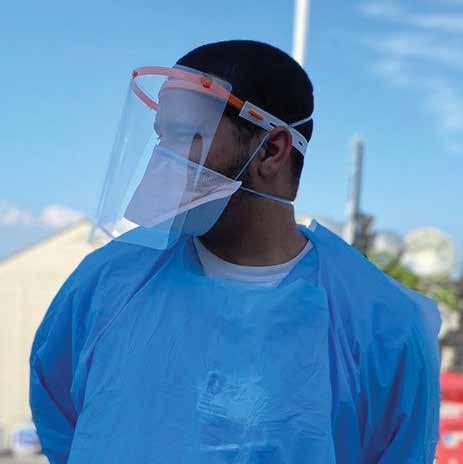
as much as possible, many others, didn't have that luxury. Especially healthcare workers. They’re on the front lines, interacting with and treating people who are sick, injured or in need of assistance. And many of those healthcare heroes, at least in the capital region, received their degrees from Central Penn College.
In fact, more than 1,000 students have graduated from our healthcare-related programs in…
Physical Therapist Assistant (PTA)
Occupational Therapy Assistant (OTA)
Medical Assisting (MA)
Health Science
Healthcare Management
Phlebotomy Technician
Resiliency
Last year, after the college moved to remote operations in mid-March of 2020, President Linda Fedrizzi-Williams offered encouraging words to students and the larger campus community:
Right now, our country and the world are being challenged by the COVID-19 pandemic. Our normal way of life has been altered, and we all are adjusting to this new reality.
These are indeed uncertain times, and that makes all of us anxious.
But you know what? We can get through this. We’re Central Penn College. We’ve been tested before and we’ll be tested again. We’re scrappy. We’re fierce. We’re resilient. Her words were—and are—a testament to the spirit that drives Central Penn students and alumni, and that quality perhaps has been in no greater abundance than by our healthcare grads.
For this story, we interviewed eight alumni who work in healthcare settings, including large hospitals, small PTA offices and patients' homes. While all of their stories are different, the similarities include:
A genuine care for the patients they interact with and/ or treat
A deeper bond with their coworkers
A commitment to patient safety and personal safety
An abiding concern about keeping their family safe
Participants
Stephen Campbell, ’11, AAS, Physical Therapist Assistant – Teaches at the Lancaster Center and works as a PTA at a local hospital Isaiah Dorsey, ’18, AAS, Medical Assisting – Certified Medical Assistant at Penn State Health Holy Spirit Medical Center Urgent Care Mariano Figueroa-Perez, ’16, AAS, Physical Therapist Assistant – PTA and certified/licensed pedorthist Madeline (Maddie) Gleason, ’19, AAS, Occupational Therapy Assistant – Certified Occupational Therapy Assistant at Southeastern HomeHealth Services in Marysville

Mariano Figueroa-Perez Maddie Gleason Lucy Hunsberger
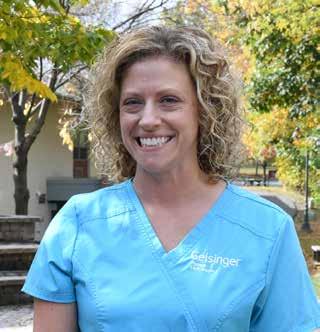
Lucy Hunsberger, ’02, ’10, AAS Medical Assisting, B.S. Business Administration – Teaches at Summerdale and works as a Certified Medical Assistant at Penn State Health Holy Spirit Mike Nguyen, ’07, AAS, Physical Therapist Assistant – PTA at Penn Medicine Home Health – Lancaster General Health Gretchen Ramsey, ’15, MPS – Consultant, Patient Experience, at Penn State Health Holy Spirit Medical Center Maria Zagursky, ’19, AAS, Physical Therapist Assistant – PTA at Gilbert Physical Therapy in Mechanicsburg
NOTE: All the healthcare alumni were interviewed during the summer of 2020 about their experience with the pandemic during the spring and early summer last year.
Recent Grads
Since 1881, Central Penn College has been a leader in career-focused education. “More than 90% of recent CPC graduates have landed jobs in their chosen fields or continued their education, according to our most recent one-year graduate survey.” Three healthcare alumni who graduated in 2018 and 2019 from three different programs share their experiences.
Certified Medical Assistant Isaiah Dorsey has been in the eye of the storm at the COVID tent at Geisinger Holy Spirit* in Camp Hill. Previously, he worked as an emergency department clinical technician at UPMC.
“It’s been very busy,” said the Shippensburg resident. “A big positive has been meeting so many coworkers and getting to know them.”
Seamless Transition
For Maria Zagursky, the transition from college to work was rather seamless. In fact, not much changed for her at Gilbert Physical Therapy in Mechanicsburg… well, except for her job title and duties. “I started as an aide and did that for four years, decided to go to Central Penn for my PTA degree and have been working as a PTA since,” said Zagursky.
COVID has caused some changes to her work environment. “We do our part to keep our patients safe by taking temperatures, wearing our masks and maintaining social distance throughout the clinic,” said Zagursky. “It is our responsibility as a healthcare provider to educate and protect each other to help stop the spread.”
*Geisinger Holy Spirit is now known as Penn State Health Holy Spirit Medical Center.
Persistence Pays Off
OTA Maddie Gleason, who graduated in 2019, initially had trouble securing a position. “Due to COVID-19, the job market decreased dramatically. I struggled to find a job, and if companies were hiring, they were looking for COTAs [certified OTAs] who already had experience in the field,” said Gleason.
She persisted and eventually landed a homecare position with Marysville-based Southeastern HomeHealth Services in August. “This job was a miracle that came my way and I just got lucky… even luckier that the job is in the county where I live,” said the Newport resident.
Her advice to her fellow OTA alumni and current OTA students: “I want to continue to encourage all of my former classmates and those who are going through the program now, to take every chance they get and to apply to any job they see. You never know when someone will take a chance on you.”
Instructors & Healthcare Workers
Most Central Penn professors have worked or continue to work in their field. The ability to bring “real world” experience into the classroom has been one of the strengths of a Central Penn education since the college was founded years ago.
Stephen Campbell and Lucy Hunsberger are both key members of the Allied Health faculty. Campbell ’11, AAS, PTA, teaches a variety of PTA courses at the Lancaster Center. He’s a passionate advocate for lifelong learning: “Never stop learning,” he says. “The therapy field is ever evolving and keeping up with evidence-based practice is critical for providing patients with the care they need.”
He also works every other weekend at a local hospital, providing care and therapy to patients who are sick, injured or recovering from surgery. His philosophy is simple: “No matter who or what type of condition you are treating, remember to treat the whole person—not just the injury.”
For Campbell, patient care involves a good deal of emotional support, too. “It’s a huge connection you have to make with patients,” he says. “Some people need to know everything’s going to be okay. They need to hear that so that they can get better.”
Mike Nguyen
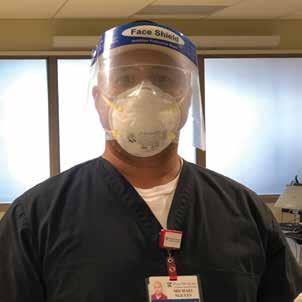
Maria Zagursky
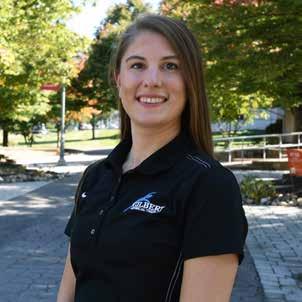
Gretchen Ramsey
COVID Tent
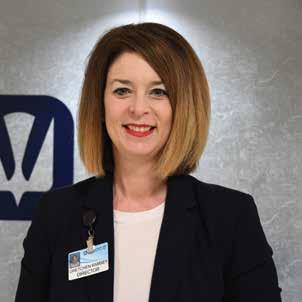
Hunsberger currently teaches online and traditional classes in the Medical Assisting program and in the Allied Health department at Summerdale. She earned two degrees from Central Penn: an AAS in Medical Assisting in 2002 and a bachelor’s in Business Administration. She works part-time as a certified medical assistant (CMA) at Geisinger Holy Spirit Urgent Care. Along with Isaiah Dorsey, she works in the COVID tent at the facility. “Our urgent care center has completely changed since COVID hit in March,” says Hunsberger. “We have become one of the main COVID testing centers for Cumberland County and that required us to move urgent care to a local doctor’s office, so we could still see non-COVID patients. However, the urgent care staff remained and still run the COVID tent.”
Prior to COVID, Hunsberger’s shifts were spent rooming patients, checking vital signs, taking patients’ complete history, administering medications, assisting the provider with minor office procedures, drawing blood and scheduling referral appointments for patients.
“I now do COVID screenings and swabbing of patients,” said Hunsberger, who also holds a master’s in Adult Learning from Walden University. “We have just started using part of urgent care for actual urgent care visits anything not related to COVID—but the vast majority of patients have COVID symptoms, so we treat them in the COVID tent.” She looks forward to going back to the pre-pandemic time. “I do miss the ‘normal’ urgent care visits and seeing patients without having to be in full PPE [personal protection equipment].”
Staying Safe
Campbell has a goatee, which presents a problem in the age of COVID. He can’t wear an N95 respirator because it won’t seal properly due to his facial hair. And without proper safety equipment, he can’t treat COVID and COVID-suspicious patients.
However, there is another option… the PAPR, which stands for powered air-purifying respirator. “If you saw the movie The Martian with Matt Damon, that’s kinda what the PAPR looks like. It has a backpack that pumps filtered air into the back of a giant helmet,” says Campbell.
Enhanced safety protocols are a necessity in the COVID era to protect both healthcare workers and their families. Campbell describes an elaborate ritual of scheduling COVID patients usually at the end of the day… gearing up in full PPE, including the PAPR, in a special germ-free room… stashing a change of clothes… before providing treatment to ill and/or deconditioned patients.
Once the session is over, he returns to the room and reverses the entire process, tossing dirty scrubs into the special laundry container and then changing into his driving-home clothes. “As soon as I get home, I take off my shoes, throw my clothes into the washer and go take a shower immediately,” said Campbell.
Hunsberger describes a similar process. “We make sure to change our clothes and shoes and shower as soon as we get home all in hopes to stop the spread from your family,” she said.
Working the COVID tent presents its own challenges. “We are the frontline workers—we are the ones in the trenches testing 90–100 patients a day during the busy time,” she said.
The “scariest part” for Hunsberger and her fellow workers was in late February and early March before Pennsylvania had its first official case. “We were seeing COVID-19 in urgent care, but not even knowing it at the time, because no one knew the stats or knew much about it. We were dealing with so many unknowns and things changed daily. It honestly was one of the most exhausting times in healthcare for me,” she said.
Connecting with Patients, Connecting with Co-Workers
Despite the additional safety precautions, patient care is still paramount, says Campbell. “Patients need that heartfelt support. It’s a huge connection you have to make. They’re in pain. They’ve got to know you care.”
For Hunsberger, patient care has gone hand-in-hand with becoming part of a larger healthcare family. The COVID tent recruited healthcare workers from different parts of the hospital… people with whom she hadn’t worked with before.
“In the midst of the really busy and stressful time—April was the worst month—we became a family that pulled together to make sure we were getting patients tested ASAP and that we were looking out for each other to protect each other from COVID,” she said.
“I feel honored and blessed to have been able to work with so many wonderful healthcare professionals during this very challenging time,” said Hunsberger.
Two PTAs, Two Different Settings
The arrival of the pandemic may have overshadowed other health concerns, but that doesn’t diminish the need to treat diseases and conditions, as Mike Nguyen and Mariano Figuero-Perez can both attest. The two PTAs have been consistently seeing patients since March when COVID-19 officially arrived in Pennsylvania.
Nguyen works in home healthcare for Penn Medicine Home Health – Lancaster General Health, while FigueroPerez treats patients on-site at Cardin & Miller Physical Therapy in Harrisburg.
Nguyen visits homebound patients who were recently hospitalized for surgery, injuries from falls, and generalized weakness. “My job is to help them become functional,” he said, “so that leaving their home is not as challenging because they are too weak or too deconditioned. I work on strengthening, balance and endurance to help them become independent again.“
In addition to being a PTA, Figuero-Perez is a certified pedorthist. “Some of my job duties range from treating patients with orthopedic conditions to designing foot/ ankle braces, custom orthotics and custom diabetic shoes,” he said. “And for the past two years, I have taken the responsibility of providing proper footwear options to the diabetic population in order to decrease the risk of lowerlimb amputations.“
The Impact of the Coronavirus
“COVID has definitely changed the dynamics of my job,” said Figuero-Perez. “I had to learn how to deliver physical therapy services through my computer (virtual therapy), adapt to wearing a face mask and face shield for up to 11-hour work shifts, and act not only as a clinician, but also as a patient care coordinator.
For Nguyen, not too much has changed, except the use of additional protective equipment. “I always wear a surgical mask and goggles when working with patients,” he said. “If they are COVID-suspicious or have COVID, then I have to wear the proper PPE, which includes a gown, gloves, N-95 mask, goggles and face shield. Hair covering and shoe coverings may have to be worn as well.”
While his main job has been relatively unaffected, he hasn’t been able to work as a lab assistant in the Lancaster Center alongside Stephen Campbell due to COVID. Nguyen looks forward to returning soon.
Silver Lining
For both Nguyen and Figuero-Perez, the pandemic has given them a deeper appreciation for the impact they have on their patients. “Being able to continue working with my patients and getting them better have been the most rewarding part of my job,” said Nguyen. “There are many patients who are very weak and fragile and who benefit from someone coming to their home for therapy.”
Patients are more aware of their own health, said FigueroPerez. “Some of the best experiences I have had since the beginning of this crisis relate to seeing people being more conscious about their health and wellness, and starting to hear more physical therapy providers talking more openly about mental health, which, in my opinion, is a big step forward in my profession.”
More Than One Path to a Healthcare Career
Unlike the seven other alumni featured in this story, Gretchen Ramsey doesn’t have a healthcare-specific degree. She earned her master’s in organizational leadership from Central Penn in 2015. She is the the patient experience at the Penn State Health Holy Spirit Medical Center (formerly Geisinger Holy Spirit).
That position entails “coaching and training our physicians, nurses and ancillary staff on communication techniques to improve the patient’s perception on the great care we provide in our hospital, emergency room and outpatient clinics,” says Ramsey. In addition, she tracks the patient experience data and shares it with staff, leadership and the board of directors.
However, when COVID hit, she pivoted to “connectivity––connectivity of patients separated from their families and connectivity between the larger system-wide policies and our hospital.”
Instead of focusing strictly on external communication (patients), she has turned to messaging the hospital’s internal team. “During the height of the COVID-19 pandemic, my role took a bit of U-turn as I also became responsible for making the hospital staff feel well-cared for,” said Ramsey.
“I coached and supported care team members and employees who staffed the screening tables at Holy Spirit Hospital.” She also helped manage and coordinate the many food, beverage and candy donations from the community. Ramsey used her communication background to boost morale for hospital staff. “I found that my writing skills, which I refined during my time in the master’s program, came in handy,” she said. “On a daily basis, I sent an uplifting and informative message to staff regarding the ever-changing visitor and safety policies.”
The Reality of COVID
“One of the most poignant moments for me was connecting an end-of-life patient with her only child in Colorado during the last moments of her life,” said Ramsey. “The nursing team reached out to me and I was fortunate enough to know incredible colleagues in our IT department who showed up with an iPad and support to connect this mother to her daughter during the last moments of her life. This happened before the system deployed iPads to each campus for situations like this.”
Merger Underway
Not only does she work at a hospital in the midst of a global pandemic, but also Geisinger Holy Spirit is in the process of merging with Penn State Health. Ramsey has been asked to co-lead the Patient Experience integration team. “I am leaning on my education in organizational leadership from Central Penn College to help me ‘captain my own ship’ through this change,” said Ramsey.
“The lessons, guidance and straightforward advice of the professors at Central Penn helped to shape me into the leader I am today.” V









